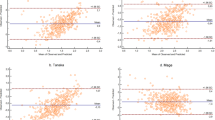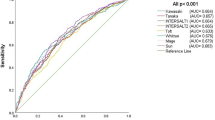Abstract
Background
We aimed to test the difference between estimates of dietary sodium intake using 24-h diet recall and spot urine collection in a large sample of New Zealand adults.
Methods
We analysed spot urine results, 24-h diet recall, dietary habits questionnaire and anthropometry from a representative sample of 3312 adults aged 15 years and older who participated in the 2008/09 New Zealand Adult Nutrition Survey. Estimates of adult population sodium intake were derived from 24-h diet recall and spot urine sodium using a formula derived from analysis of INTERSALT data. Correlations, limits of agreement and mean difference were calculated for the total sample, and for population subgroups.
Results
Estimated total population 24-h urinary sodium excretion (mean (95% CI)) from spot urine samples was 3035 mg (2990, 3079); 3612 mg (3549, 3674) for men and 2507 mg (2466, 2548) for women. Estimated mean usual daily sodium intake from 24-h diet recall data (excluding salt added at the table) was 2564 mg (2519, 2608); 2849 mg (2779, 2920) for men and 2304 mg (2258, 2350) for women. Correlations between estimates were poor, especially for men, and limits of agreement using Bland–Altman mean difference analysis were wide.
Conclusions
There is a poor agreement between estimates of individual sodium intake from spot urine collection and those from 24-hour diet recall. Although, both 24-hour dietary recall and estimated urinary excretion based on spot urine indicate mean population sodium intake is greater than 2 g, significant differences in mean intake by method deserve further investigation in relation to the gold standard, 24-hour urinary sodium excretion.
This is a preview of subscription content, access via your institution
Access options
Subscribe to this journal
Receive 12 print issues and online access
$259.00 per year
only $21.58 per issue
Buy this article
- Purchase on Springer Link
- Instant access to full article PDF
Prices may be subject to local taxes which are calculated during checkout


Similar content being viewed by others
References
Asaria P, Chisholm D, Mathers C, Ezzati M, Beaglehole R. Chronic disease prevention: health effects and financial costs of strategies to reduce salt intake and control tobacco use. Lancet. 2007;370:2044–53.
Bibbins-Domingo K, Chertow GM, Coxson PG, Moran A, Lightwood JM, Pletcher MJ, et al. Projected effect of dietary salt reductions on future cardiovascular disease. New Engl J Med. 2010;362:590–9.
World Health Organization. Guideline: sodium intake for adults and children. Geneva: World Health Organization (WHO); 2012.
World Health Organization. Reducing salt in populations: report of a WHO forum and technical meeting 5–7 october 2006. Paris, France, Geneva: World Health Organization; 2006.
World Health Organization. Follow-up to the political declaration of the high-level meeting of the general assembly on the prevention and control of non-communicable diseases: sixty-sixth world health assembly (WHA66.10). Geneva: World Health Organization; 2013.
Cogswell ME, Zhang Z, Carriquiry AL, Gunn JP, Kuklina EV, Saydah SH, et al. Sodium and potassium intakes among US adults: NHANES 2003-2008. Am J Clin Nutr. 2012;96:647–57.
University of Otago and Ministry of Health. Methodology report for the 2008/09 New Zealand Adult Nutrition Survey. Wellington: Ministry of Health; 2011.
Sanchez-Castillo CP, Branch WJ, James WPT. A test of the validity of the lithium-marker technique for monitoring dietary sources of salt in man. Clin Sci. 1987;72:87–94.
World Health Organization. The SHAKE technical package for salt reduction.. Geneva: World Health Organization; 2016.
Joint Health Surveys Unit. A survey of 24 h and spot urinary sodium and potassium excretion in a representative sample of the Scottish population. National Centre for Social Research. 2007. www.food.gov.uk/multimedia/pdfs/scotlandsodiumreport.pdf
Hawkes C, Webster J. National approaches to monitoring population salt intake: a trade-off between accuracy and practicality? PLoS ONE. 2012;7:e46727.
Mente A, O’Donnell M, Rangarajan S, Dagenais G, Lear S, McQueen M, et al. Associations of urinary sodium excretion with cardiovascular events in individuals with and without hypertension: a pooled analysis of data from four studies. Lancet. 2016;388:465–75.
Huang L, Crino M, Wu JHY, Woodward M, Barzi F, Land M-A, et al. Mean population salt intake estimated from 24-h urine samples and spot urine samples: a systematic review and meta-analysis. Int J Epidemiol. 2016;45:239–50.
Cogswell ME, Wang C-Y, Chen T-C, Pfeiffer CM, Elliott P, Gillespie CD, et al. Validity of predictive equations for 24-h urinary sodium excretion in adults aged 18–39 y. Am J Clin Nutr. 2013;98:1502–13.
Bland JM, Altman DG. Statistical methods for assessing agreement between two methods of clinical measurement. Lancet. 1986;327:307–10.
Gemming L, Jiang Y, Swinburn B, Utter J, Ni Mhurchu C. Under-reporting remains a key limitation of self-reported dietary intake: an analysis of the 2008/09 New Zealand Adult Nutrition Survey. Eur J Clin Nutr. 2013;68:259–64.
Swinburn B, Ley S, Carmichael H, Plank L. Body size and composition in polynesians. Int J Obes. 1999;23:1178–83.
Swinburn BA, Ley SJ, Carmichael HE, Plank LD. Body size and composition in polynesians. Int J Obes. 1999;23:1178–83.
Bogardus C, Lillioja S, Ravussin E, Abbott W, Zawadzki JK, Young A, et al. Familial dependence of the resting metabolic rate. New Engl J Med. 1986;315:96–100.
Black A. The sensitivity and specificity of the Goldberg cut-off for EI: BMR for identifying diet reports of poor validity. Eur J Clin Nutr. 2000;54:395.
Cogswell ME, Maalouf J, Elliott P, Loria CM, Patel S, Bowman BA. Use of urine biomarkers to assess sodium intake: challenges and opportunities. Annu Rev Nutr. 2015;35:349–87.
Mercado CI, Cogswell ME, Valderrama AL, Wang C-Y, Loria CM, Moshfegh AJ, et al. Difference between 24-h diet recall and urine excretion for assessing population sodium and potassium intake in adults aged 18–39 y. Am J Clin Nutr. 2015;101:376–86.
Sivakumaran S, Huffman L, Sivakumaran S. The New Zealand Food Composition Database: a useful tool for assessing New Zealanders’ nutrient intake. Food Chem. 2016;238:101–10.
Dennis B, Stamler J, Buzzard M, Conway R, Elliott P, Moag-Stahlberg A, et al. INTERMAP: the dietary data—process and quality control. J Hum Hypertens. 2003;17:609–22.
De Keyzer W, Dofkova M, Lillegaard ITL, De Maeyer M, Andersen LF, Ruprich J, et al. Reporting accuracy of population dietary sodium intake using duplicate 24 h dietary recalls and a salt questionnaire. Br J Nutr. 2015;113:488–97.
Zhou L, Tian Y, Fu J-J, Jiang Y-Y, Bai Y-M, Zhang Z-H, et al. Validation of spot urine in predicting 24-h sodium excretion at the individual level. Am J Clin Nutr. 2017;105:1291–6.
McLean R, Williams S, Mann J. Monitoring population sodium intake using spot urine samples: validation in a New Zealand population. J Hum Hypertens. 2014;28:657–62.
Subar AF, Kipnis V, Troiano RP, Midthune D, Schoeller DA, Bingham S, et al. Using intake biomarkers to evaluate the extent of dietary misreporting in a large sample of adults: the OPEN study. Am J Epidemiol. 2003;158:1–13.
Brown IJ, Dyer AR, Chan Q, Cogswell ME, Ueshima H, Stamler J, et al. Estimating 24-hour urinary sodium excretion from casual urinary sodium concentrations in western populations: the INTERSALT study. Am J Epidemiol. 2013;177:1180–92.
Allen NB, Zhao L, Loria CM, Van Horn L, Wang C-Y, Pfeiffer CM, et al. The validity of predictive equations for 24-hour sodium excretion: the MESA and CARDIA uniary sodium study. Am J Epidemiol. 2017;186:149–59. kwx056
Thomson CD, Colls AJ. Twenty-four hour urinary sodium excretion in seven hundred residents of Otago and Waikato. Dunedin: University of Otago; 1998.
McLean R, Edmonds J, Williams S, Mann J, Skeaff SA. Balancing sodium and potassium: estimates of intake in a new zealand adult population sample. Nutrients. 2015;7:8930–8.
Freedman LS, Kipnis V, Schatzkin A, Tasevska N, Potischman N. Can we use biomarkers in combination with self-reports to strengthen the analysis of nutritional epidemiologic studies? Epidemiol Perspect Innov. 2010;7:2.
Willett WC, Hu FB. Not the time to abandon the food frequency questionnaire: point. Cancer Epidemiol Biomarkers Prev. 2006;15:1757–8.
Prentice RL, Huang Y, Neuhouser ML, Manson JE, Mossavar-Rahmani Y, Thomas F, et al. Associations of biomarker-calibrated sodium and potassium intakes with cardiovascular disease risk among postmenopausal women. Am J Epidemiol. 2017;186:1035–43.
Huang Y, Van Horn L, Tinker LF, Neuhouser ML, Carbone L, Mossavar-Rahmani Y, et al. Measurement error corrected sodium and potassium intake estimation using 24-hour urinary excretion. Hypertension. 2014;63:238–44.
Mente A, O’Donnell MJ, Rangarajan S, McQueen MJ, Poirier P, Wielgosz A, et al. Association of urinary sodium and potassium excretion with blood pressure. New Engl J Med. 2014;371:601–11.
Terry AL, Cogswell ME, Wang C-Y, Chen T-C, Loria CM, Wright JD, et al. Feasibility of collecting 24-h urine to monitor sodium intake in the National Health and Nutrition Examination Survey. Am J Clin Nutr. 2016;104:480–8.
Thomson BM, Vannoort RW, Haslemore RM. Dietary exposure and trends of exposure to nutrient elements iodine, iron, selenium and sodium from the 2003-4 New Zealand Total Diet Survey. Br J Nutr. 2008;99:614.
Poslusna K, Ruprich J, de Vries JH, Jakubikova M, van’t Veer P. Misreporting of energy and micronutrient intake estimated by food records and 24 h recalls, control and adjustment methods in practice. Br J Nutr. 2009;101(S2):S73–S85.
Funding
The New Zealand Ministry of Health funded the 2008/09 New Zealand Adult Nutrition Survey. The New Zealand Crown is the owner of the copyright of the survey data. The results presented in this paper are the work of the authors.
Author contributions
R.M.M. designed the study, analysed the data and wrote the manuscript. S.M.W. advised on study design, data analysis and contributed to the writing of the manuscript. L.A.T.M. analysed the data, advised on study design and contributed to the writing and reviewing of the manuscript. J.I.M. advised on study design reviewed the manuscript.
Author information
Authors and Affiliations
Corresponding author
Ethics declarations
Conflict of interest
The authors declare that they have no conflict of interest.
Rights and permissions
About this article
Cite this article
McLean, R.M., Williams, S.M., Te Morenga, L.A. et al. Spot urine and 24-h diet recall estimates of dietary sodium intake from the 2008/09 New Zealand Adult Nutrition Survey: a comparison. Eur J Clin Nutr 72, 1120–1127 (2018). https://doi.org/10.1038/s41430-018-0176-0
Received:
Revised:
Accepted:
Published:
Issue Date:
DOI: https://doi.org/10.1038/s41430-018-0176-0
This article is cited by
-
Role of high-salt diet in non-alcoholic fatty liver disease: a mini-review of the evidence
European Journal of Clinical Nutrition (2022)
-
Sodium in the New Zealand diet: proposed voluntary food reformulation targets will not meet the WHO goal of a 30% reduction in total sodium intake
European Journal of Nutrition (2022)
-
Association of dietary patterns with gut microbiota in kidney stone and non-kidney stone individuals
Urolithiasis (2022)



